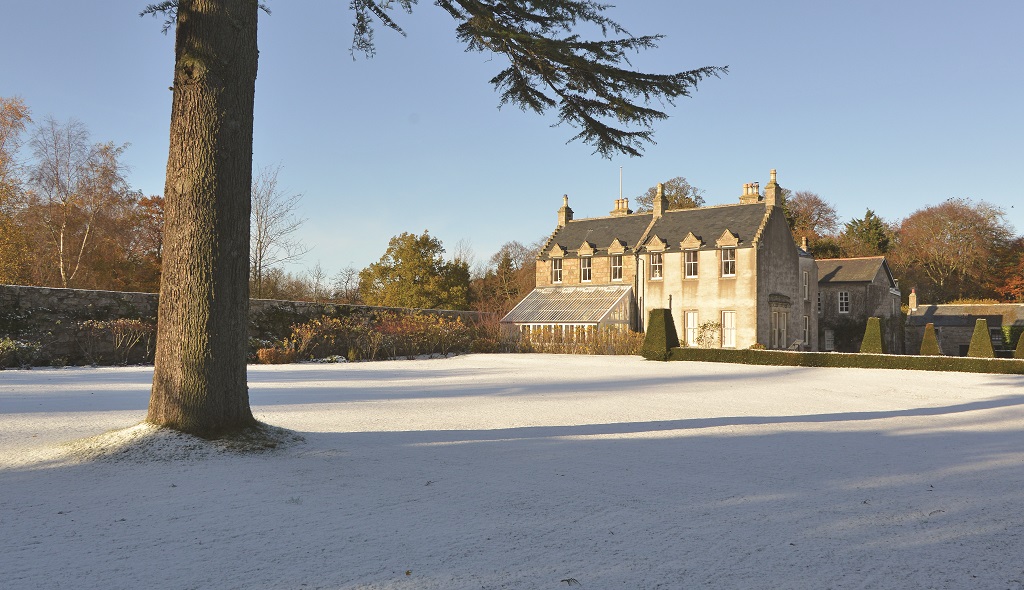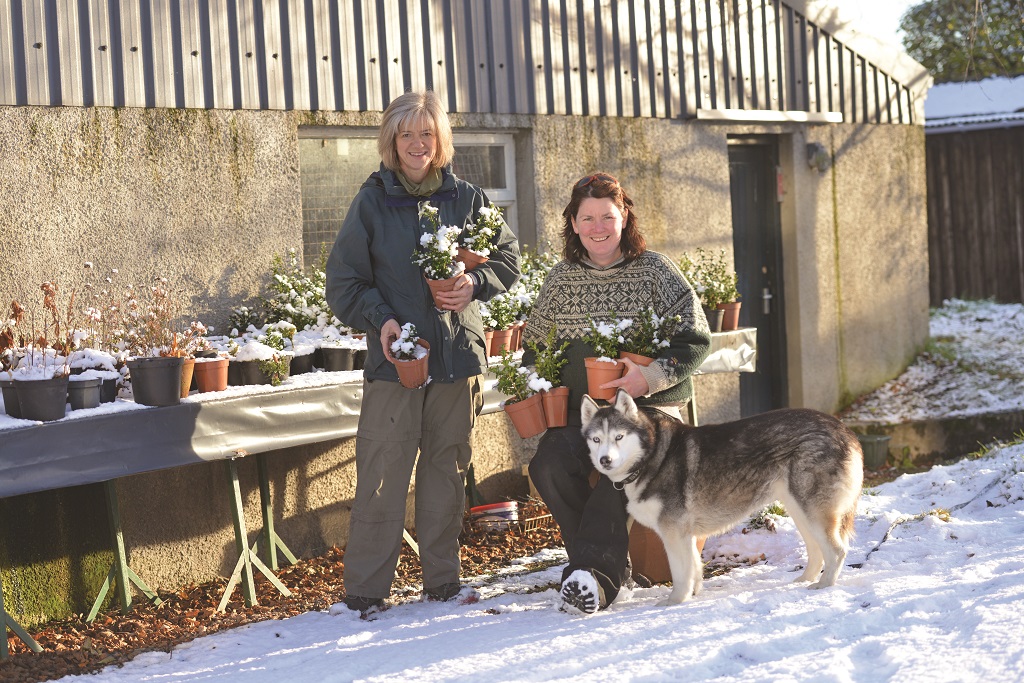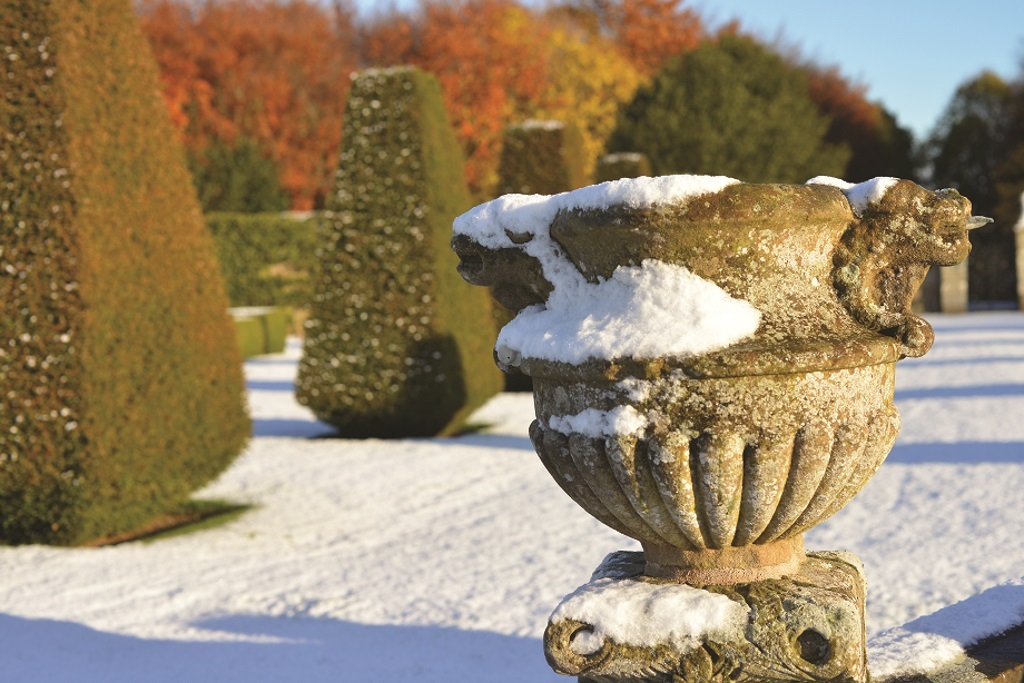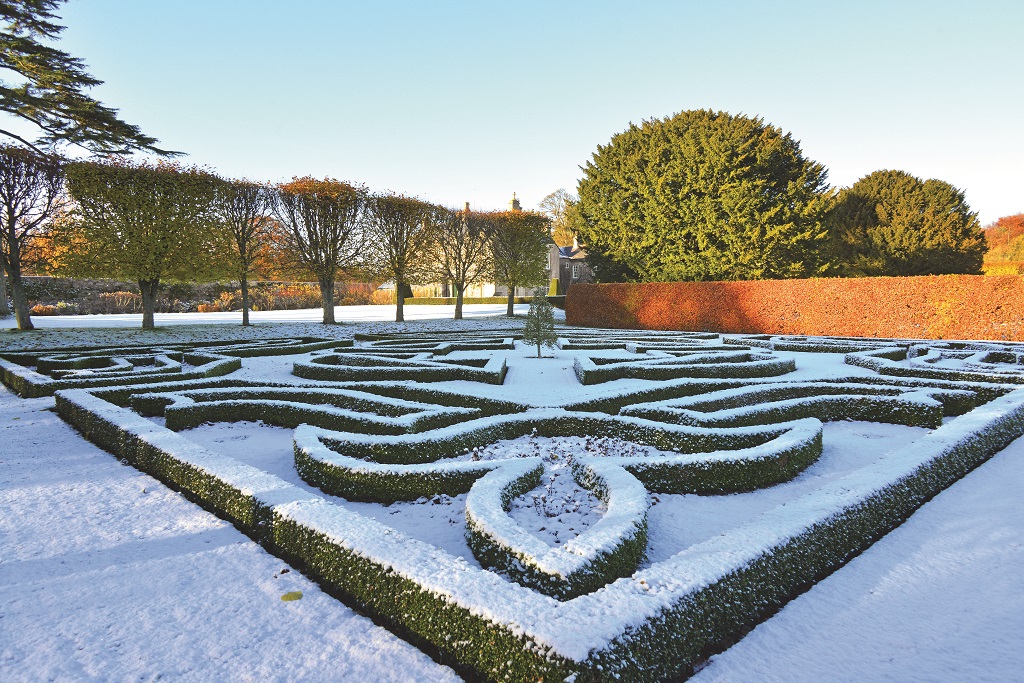
A garden made from blood, sweat and tears
A bloody battle in 1639 provides the backdrop for Pitmedden, a remarkable Aberdeenshire garden brought back to life by the National Trust for Scotland.
Nothing prepares you for your first sight of the formal, 17th century formal gardens at Pitmedden, the National Trust for Scotland garden north of Aberdeen.
Certainly not the garden’s remote location, deep in rolling countryside, nor the modest façade of the 19th century stone house built on the site of an earlier dwelling.
Tucked discreetly behind the house the garden is laid out on three levels. The top, stone-edged terrace is defined by granite paths and backed by a row of pleached lime trees enlivened by a bronze duo of boxing hares. A pair of box-edged parterres hint at the splendours below, which are partially concealed by the elegant stone balustrade and granite retaining walls.

Pitmedden House was build in 1863 (Photo: Angus Blackburn)
Spread out below, and reached by an imposing parallel stone steps, is a striking classical design of crisp rectangles framing curved shapes reminiscent of the best formal French and Italian gardens. Divided vertically by sentinels of pyramid-shaped yews that run the length of both terraces, the scheme is punctuated with a multi-faceted stone sundial and an imposing fountain.
A reminder that this is indeed Scotland comes from the saltire and thistle incorporated into the design. Espaliered apples line the outer walls while a line of yew buttresses flank the lower wall.
Stunning as this layout is in summer when the shapes are packed with vibrantly coloured annuals and the generous, south and west facing herbaceous borders are bright with colour, the garden is especially evocative in winter when the crisp box hedges are clearly defined by frost or snow.
Susan Burgess, the property manager and head gardener who departed in 2018 after 24 years there, resided in a house overlooking the garden. Living on site is a real privilege, especially in winter, she explains.

Susan Burgess and Brona Keenan (Photo: Angus Blackburn)
‘In winter Pitmedden is stripped of all its vibrant colours and is back to the basic outline,’ she says. ‘In the morning I open my curtains to look out over the garden and see the frosty box and yew topiary often set against a blue sky. All day you see the shadows of the yew trees against the snow, it’s stunning.’
The history of the garden is intriguing and goes some way to explaining the existence of this formal garden in so remote a location. It was originally laid out by Sir Alexander Seton in 1675, who engraved his initials alongside those of his wife Dame Margaret Lauder on the lintel at the garden entrance. Alexander was brought up by his kinsman, George, Lord Seton in East Lothian, after the death of his father John at the Battle of the Bridge of Dee in 1639. There, he was almost certainly influenced by the splendid, but now lost, garden Lord Seton created at Niddry Castle.
By the time the NTS acquired the garden in 1952 from Major James Keith all that remained of the original garden was the magnificent layout of wide stone-framed and walled terraces. Most of the planting had disappeared with the exception of three noble yews, and in the then austere post-war climate Major Keith ran the three-acre lower garden as a market garden. The upper terrace was densely planted with trees.
With an inspired vision for this historic site the NTS commissioned the restoration of the gardens under the direction of Dr James Richardson, a former Inspector of Ancient Monuments, who also redesigned the formal box parterre at Edzell Castle, in Angus.

(Photo: Angus Blackburn)
Tragically the original plans were lost, presumably incinerated in the fire which destroyed the original house in the early nineteenth century. Using contemporary designs, Dr Richardson laid out four box parterres on the lower terrace, three of which were based on gardens laid out during the early 17th century at Holyrood House in Edinburgh. The fourth parterre, featuring an otter, was inspired by Sir Alexander’s coat of arms.
The current rejuvenation of the coat of arms adds further historical detail, explains Susan: ‘The box outline had widened and the Seton coat of arms, with its otter and flag, had lost definition.’
The Seton family flag, she continues, refers to John Seton, whose blood, when fatally wounded, ran onto the white Royal standard he was bearing. The flag was later changed to scarlet and adopted by the Seton family. ‘When Alexander’s brother, James, also fell in battle Pitmedden descended to Alexander.’
Between 30,000 and 40,000 annuals are raised on site in a glasshouse and poly tunnels, with some used for shapes, such as the half moons, hearts and the otter in the coat of arms.

(Photo: Angus Blackburn)
‘We are dictated to by the colours depicted in the Seton coat of arms,’ says Susan. ‘For the background of the otter we use silver cineraria; gold tagetes –marigolds – for the crown; and red pelargonium for the heart and drops of blood.’
While empathising the history, Susan is keen to keep the garden fresh and contemporary. ‘In addition to the garden sculpture, we have introduced a number of new and exciting events throughout the summer which adds another dimension to the visitor experience. The garden is a wonderful backdrop, particularly for outdoor theatre and music, with a music festival planned for early June and a musical weekend in mid-July.’
Pitmedden Garden, Ellon, Aberdeenshire, AB41 7PD. The walled garden is open from 1 May until the end of September. The grounds at Pitmedden are open all year round; in winter the garden can be viewed by appointment.
(This feature was originally published in 2014)
TAGS

